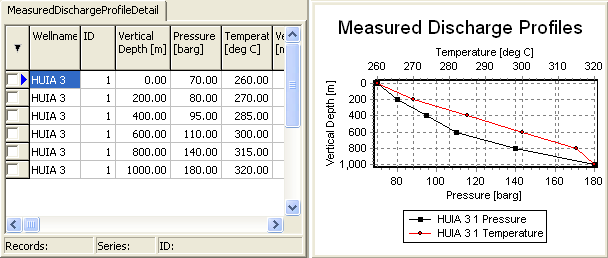
Introduction
Tutorials
Improving a discharge simulation
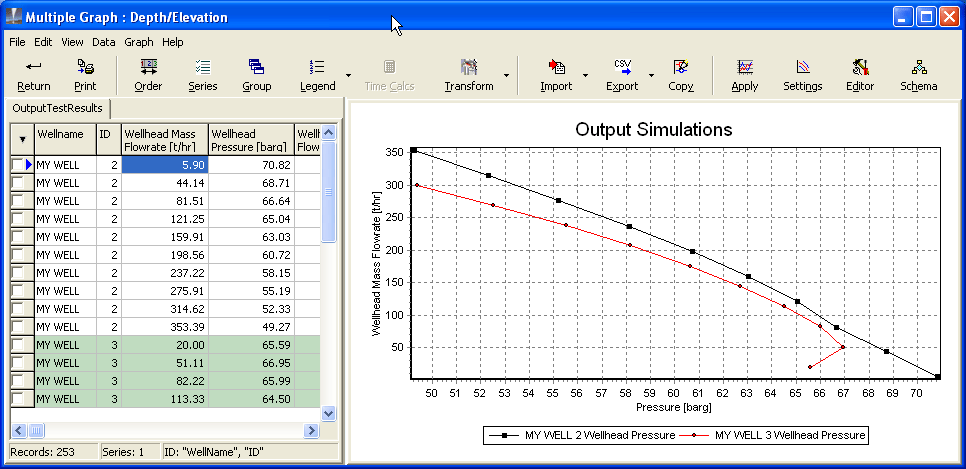
There are graph menus and graph buttons across the top.
The left of the window is the worksheet area, which displays worksheets, which are the numbers in the data set(s) that you selected to graph. In this case:
I selected two output simulations to graph, both for MY WELL, one with ID=2 and one with ID=3.
There is one worksheet with data for both output simulations. The data for the output simulation with ID=3 have a green background.
If I had selected data sets to graph with two different data types (by using Apply to 2nd Worksheet), then there would be two worksheets and two tabs.
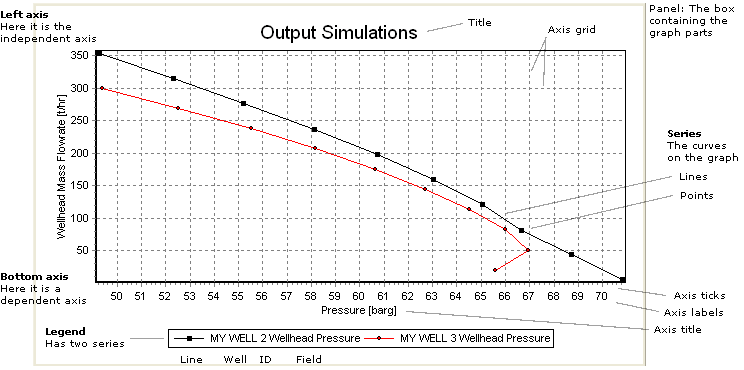
The curves on the graph are called series. This graph has two series, one black and one red.
The legend shows that:
The first series is black; is for MY WELL, is for the the output simulation with ID=2 and shows Wellhead Pressure.
The second series is red; is for MY WELL, is for the the output simulation with ID=3 and shows Wellhead Pressure.
In addition to looking at the graph, you can print it or export it in many formats, for example as a graphic, as numbers, as XML or as a text file.
| To do this with a graph ... | use |
|---|---|
| Print a graph | The Print button [Multiple Graph only] |
| The Editor window/Print tab for quick and easy printing | |
| Export a graph as a graphic (picture) file | The Editor window/Export tab/Picture tab |
| Export a graph as data (numbers) | The Editor window/Export tab/Native tab or /Data tab |
The Export button [Multiple Graph only] This works in a similar way to the standard Export function |
| To change ... | make changes in |
|---|---|
| The axis names and orientation | The Settings window |
| The series being displayed on the graph | The Series, Editor or Settings windows read more |
| The series (colours, point symbols, line types) | The Schema window for long-term changes |
| The Editor window/Series tab, to override the Schema window settings | |
| What is displayed on a geological column graph | See this tutorial |
| Zoom, scroll and change units | See here |
| The axes (title, labels, ticks, grid, position) | The Editor window/Chart tab/Axis tab and /General tab |
| The title | The Editor window/Chart tab/Titles tab |
| The Settings window to change the words of the title | |
| The legend | The Editor window/Chart tab/Legend tab |
| The Legend window [Multiple Graph only] to change the legend's format and a few other settings | |
| The panel | The Editor window/Chart tab/Panel tab |
| Paging (split a graph into several pages, for example for printing) | The Editor window/Chart tab/Paging tab |
| 3D Graphs (showing each series as a 3D ribbon) | The Editor window/Chart tab/3D tab and /Walls tab |
Open the settings window to set up the axes and series on a graph:
QuickGraph or Graphical Results: click the Graph menu, then click Graph Settings.
Multiple Graph: click the Settings button.
To select the series to display, you could also use the Series window [Multiple Graph only] or the Editor window.
Normally, there is a separate series for each well name and ID. However, in Multiple Graph you can change this grouping.
When you first start using the program, it uses built-in default graph styles. As you display graphs and change the styles these become the new default. Defaults are generally saved by node and, for Settings, by the kind of Multiple Graph. Default graph styles include:
For Settings, Schema, Time Calcs and Legend: All settings.
For Order: Worksheet column order and widths.
For Import & Export: Column settings and file path.
To start, select a typical discharge simulation and click QuickGraph. Ignore the graph for now. Click Graph, then Settings to open the Settings window:
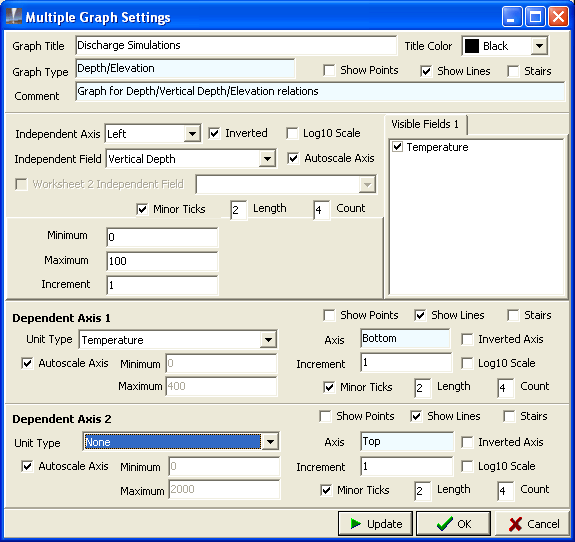
Change the settings to look like the window above:
Independent axis: Select Vertical Depth (a field in the discharge simulation) from the dropdown list; select Left to have this axis on the left; tick Invert to have zero depth at the top of the axis; tick Autoscale Axis to let the Graph module handle the axis numbers.
Dependent axis 1: Select Temperature (a unit type in the discharge simulation) from the dropdown list; tick Autoscale Axis again.
Dependent axis 2: Select None from the dropdown list.
At the top of the window, tick Show Lines and untick Show Points (there are usually many points, and displaying them will clutter the graph).
Visible Fields 1: Ensure Temperature is ticked.
Click OK:
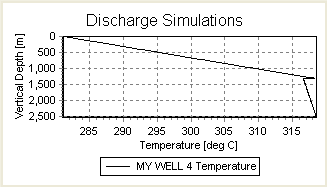
Open the Settings window and change:
At the top of the window, tick Show Points to display the points.
Click OK: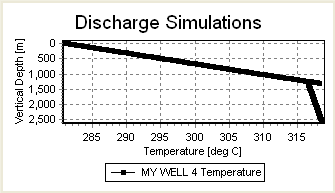
There are many points on the series, which overlap and make the line fat. Open the Settings window again and untick Show Points.
Open the Settings window and change:
Dependent axis 2: Select Enthalpy (a unit type in the discharge simulation); tick Autoscale Axis: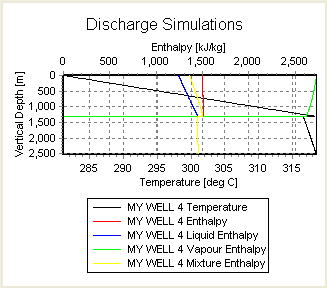
The graph has four curves for Enthalpy. This is because you selected a unit type of Enthalpy for the second dependent axis, and the discharge simulation has four fields with a unit type of Enthalpy.
Open the Settings window and change:
Visible Fields 1: Untick Liquid Enthalpy, Vapour Enthalpy and Mixture Enthalpy.
Click OK: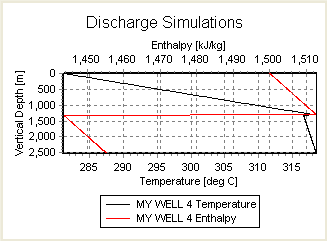
The above graph has the Enthalpy and Temperature axes autoscaled, which makes a busy-looking graph. To manually scale the axes, open the Settings window and change:
Dependent axis 1: Untick Autoscale Axis. Set Minimum to 0 and Maximum to 400. These numbers are Temperatures [degC], because Dependent axis 1 is Temperature.
Dependent axis 2: Untick Autoscale Axis. Set Minimum to 0 and Maximum to 2000. These numbers are Enthalpies [kJ/kg], because Dependent axis 1 is Enthalpy.
Click OK: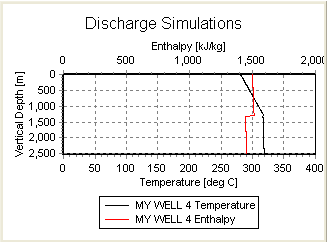
In the graph above:
the independent axis was vertical depth
the dependent axes were temperature and enthalpy.
This is how we usually think of the data, because:
vertical depth is an independent variable
and in the discharge simulation each temperature and enthalpy is calculated for a particular depth.
However, in the graph module, any field can be the independent axis, and any data types can be the dependent axes. In this example, you will display a graph of temperature against enthalpy:
Open the Settings window and change:
Independent axis: Select Enthalpy; Untick Invert to have zero enthalpy at the bottom of the axis; tick Autoscale Axis.
Dependent axis 1: Select Temperature; tick Autoscale Axis.
Dependent axis 2: Select None
Click OK: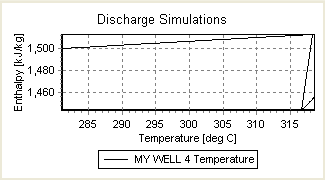
Increment is the change in value between numbers along a graph axis. For Increment = 20:

For Increment = 10:

For small values of Increment, there are too many numbers to fit along an axis, and WellSim just leaves some out. For Increment = 1:

You can also set Increment to zero, and we recommend this:

For a log axis, Increment works differently, see below.
To change an axis to Log 10, tick the box in settings. A log 10 axis is green:
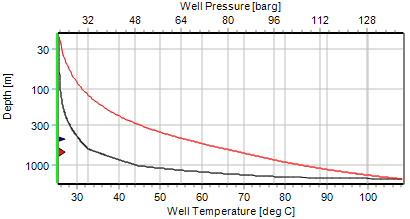
In the Settings menu, the word Increment changes to # per decade:
# per decade for Depth is 2.There are three ways to zoom: zoom all directions, zoom dependent axis or zoom independent axis. To set the zoom:
In Multiple Graph, click the Graph; or for Quick Graph, in the home window click the Quick Graph.
Click Set zoom direction and click an option in the flyout menu:
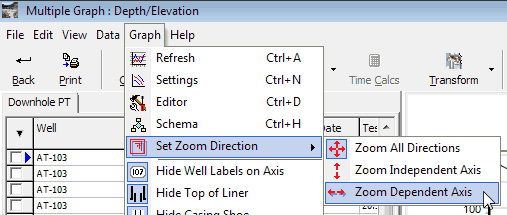
To zoom, move the cursor on the graph to the top, left of where you want to see, hold down the left mouse button and drag to the bottom, right of where you want to see; release the button. The shape of the cursor changes to show what will zoom.
Zoom all directions
This is the normal zoom, for example to inspect a part of a series in detail. The cursor is a horizontal and vertical arrow. To zoom, move the cursor to the top, left of where you want to see, hold down the left mouse button and drag to the bottom, right of where you want to see:

Release the mouse. Both axes zoom:

Returning to normal
Hold the left mouse button down on the graph and drag anywhere up and to the left:
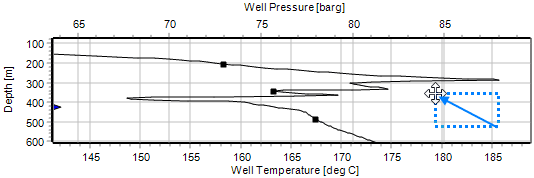
Release the button:
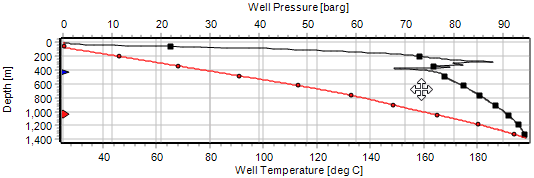
Zoom independent axis
This zooms the independent axis but not the dependent axis. The cursor is an arrow in the direction of the independent axis. In this example, depth is the independent axis; depth is the vertical axis so the cursor is a vertical arrow. When you zoom, it zooms depth but not the horizontal axis:


To return to normal: Hold the left mouse button down on the graph, drag anywhere up and to the left, release.
Zoom dependent axis
This zooms the dependent axis but not the independent axis. The cursor is an arrow in the direction of the dependent axis. In this example, well pressure and temperature are is the dependent axis; these are horizontal so the cursor is a horizontal arrow. When you zoom, it zooms the horizontal but not the depth axis:


To return to normal: Hold the left mouse button down on the graph, drag anywhere up and to the left, release.
Scrolling moves all series (and axes) in any direction, so that you can see another part of a graph; usually a zoomed graph, as here. Hover the cursor over the graph. Hold the right mouse button down and drag the graph within its axes. Release the button.
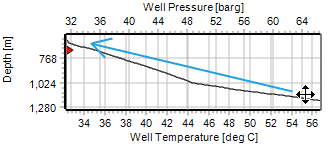
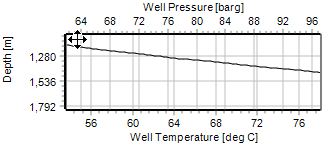
To return to normal: Hold the left mouse button down on the graph, drag anywhere up and to the left, release.
Dragging an axis moves that axis and any of its series, so that you can see another part of a graph; usually a zoomed graph, as here. Hover the cursor over the graph axis; the cursor changes to a  . Hold the left mouse button down and drag the axis. Release the button.
. Hold the left mouse button down and drag the axis. Release the button.
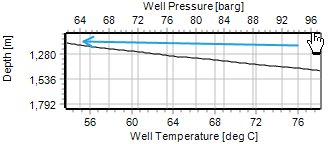
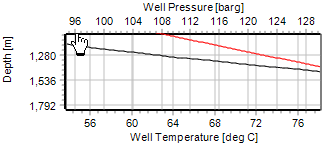
Here, we dragged the well pressure axis to the left so we could see the well pressure and well temperature series together.
To return to normal: Hold the left mouse button down on the graph, drag anywhere up and to the left, release.
Right click the axis to change, click a new unit:
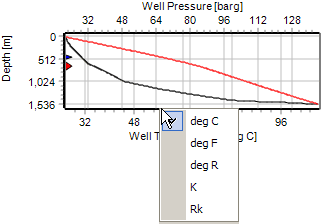
Note that when you change units like this, the axis always changes to Autoscale, because because the original Minimum and Maximum might not be appropriate for the new unit.
When you move the mouse over an item in a graph legend, the corresponding series (line) is highlit. For example:
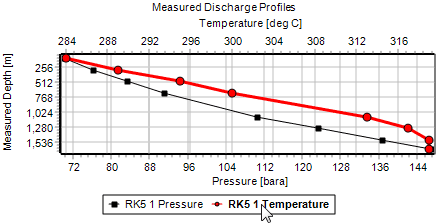
You can make all the changes listed here above to a Quick Graph or Multiple graph; for the graph you see when editing a data set, you can only zoom all directions and change axis units on the fly.
Zooming works slightly differently for a geology column graph:
zoom independent axis for obvious reasons.zoom independent axis if you start the zoom in the column graph, and zoom all directions if you start the zoom in the line graph.To customise how the graph zooms and scrolls, open the Editor window/Chart tab/General tab.
Use the schema window to set up series and point colour and style read more. To open the schema window:
QuickGraph: click the Graph menu, then click Graph Schema.
Multiple Graph: click the Settings button.
Tag two output simulations. I used the first two in the sample database for RK5:

Click Multiple Graph.
We will now change the graph to be confusing. Click Settings and if necessary change to this:
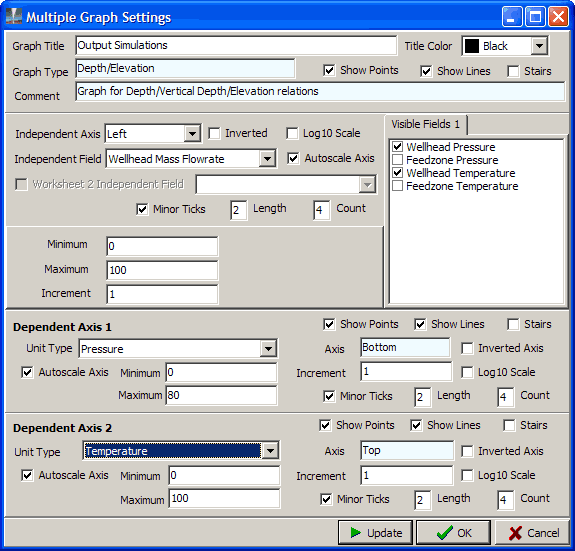
Click OK.
Click Schema and change to this:
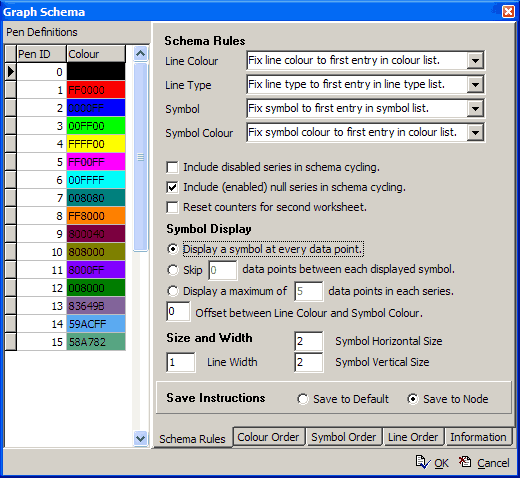
Click OK.
The graph should now look like this:
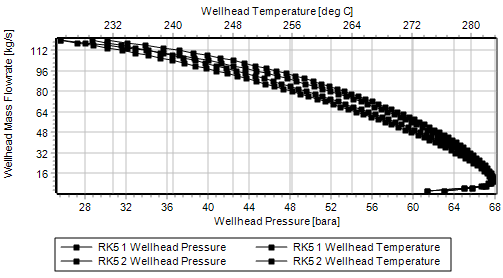
This is confusing, because it has too many points, and the lines and points are all the same colour. Click Schema and use the Schema rules tab to make the graph look better:
In Settings above you saw there were two visible fields, Wellhead Temperature and Wellhead Pressure. In the schema rules Line colour dropdown list, choose Cycle line colour by field name. This uses a different line colour for each field, so the two Temperature lines are now a different colour to the two Pressure lines.
To reduce the number of points, click Display a maximum of and enter 10 into data points in each series.
Click OK:
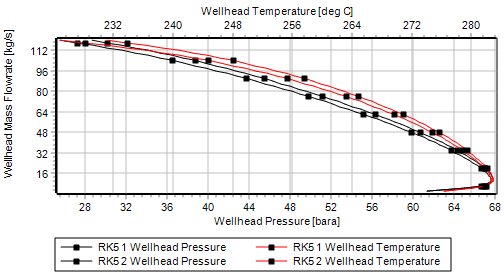
This is better but not great.
Click Schema again. There are two data sets, one for each output simulation.
Symbol dropdown list, choose Cycle symbol by data setSymbol colour dropdown list choose Cycle symbol colour by data setThis makes the points for each data set different. Click OK. The graph is now less confusing:
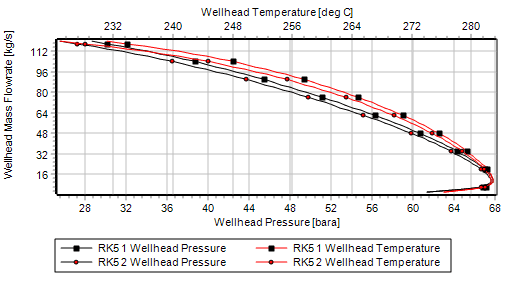
There is no correct schema for a graph, just schemas that help you interpret the graph better. Try these options for schema rules one at a time and see what works for you:
To change the line colours to other than black, then red, use schema's Colour Order tab. Change the top two Pen IDs.
Set Offet between Line Colour and Symbol Colour nonzero to further distinguish between the two data sets.
Reverse the options: cycle line colour by data set and cycle symbol and symbol colour by field name.
But probably the best thing here is to use the settings window, turn off autoscale axis for both dependent axis 1 and 2 and set the axis minimums and maximums to move the temperature and pressure series apart on the graph. You learnt how to do that above, right?
Usually you will select one or more data sets to graph before you click Graph. However, you can click Multiple Graph without selecting any data sets first, then:
This example is for a measured discharge profile:
In the main program go to the type of data set that you want to graph, measured discharge profile.
Click Multiple Graph.
The graph module starts and the worksheet shows an empty data set for a measured discharge profile:
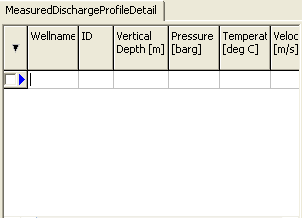
Enter data for the first vertical depth: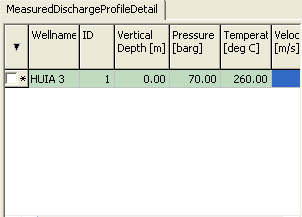
Click  (top left corner of worksheet) and click
(top left corner of worksheet) and click Save changes to accept your data for the first depth:
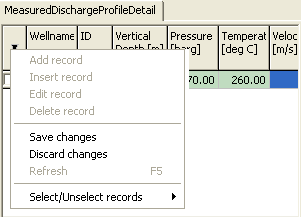
Click  again and click
again and click Add record to create a new empty row in the worksheet.
Repeat the above three steps to enter a row of data, save it and add a new record until you have entered all your data:
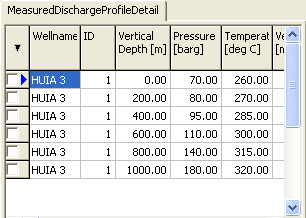
Click Settings and check these settings:
Independent axis is set to Vertical Depth, Inverted, Left, Autoscale Axis.
Dependent axis 1 is set to Pressure, Autoscale Axis.
Dependent axis 2 is set to Temperature, Autoscale Axis.
At the top of the window: The setting is Show Lines, not Show Points.
Visible Fields 1 is set to Pressure and Temperature.
Click OK:
